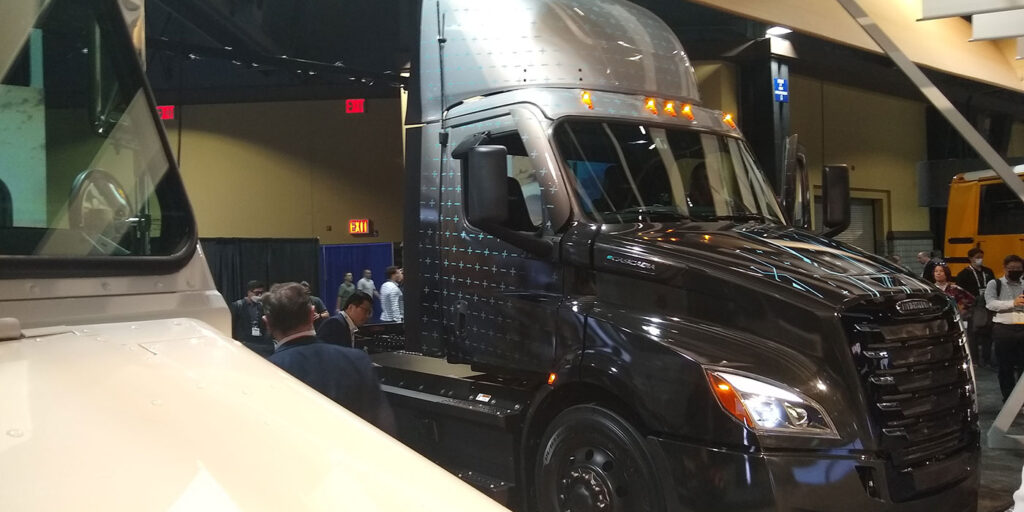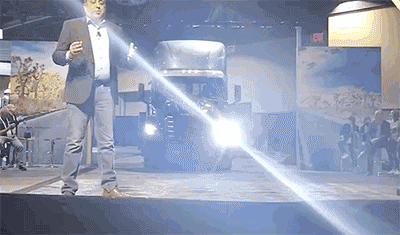At ACT Expo, held in Long Beach, Calif., Daimler Truck North America detailed the production series eCascadia, its battery electric Class 8 truck aimed at short-haul routes that allow for depot-based charging, examples of which include last mile logistics, local and regional distribution, drayage and warehouse to warehouse applications. Freightliner noted that the typical range offered is approximately 230 miles, depending on the vehicle configurations. The truck manufacturer launched into the specification nitty gritty.
Freightliner eCascadia specs at a glance
• 320-470 HP;
• Typical range of 230 miles (depending on vehicle configurations);
• Multiple battery options and maximum capacity of almost 440 kWh;
• Recharge of 80 percent in approximately 90 minutes;
• Up to 82,000 lbs max GCW (Gross Combination Weight);
• Available with single or tandem eAxle; and
• 116in. day cab configuration.
Detailing the Detroit eAxle
The Detroit eAxle is an electric drivetrain component integrated with an electric motor, transmission and specialized electronics within a compact unit, the company stated. Detroit’s ePowertrain provides two eAxle designs including a dual motor with max torque of 23,000 lb.-ft. and max power of 395 HP, and a single motor featuring a max torque of 11,500 lb-ft and max power of 195 HP.
The Detroit ePowertrain offers three battery options for a range of sizes and average, zero-to-full charging times starting with 194 kWh (one and a half to three hours), 291 kWh (two to four hours), and 438 kWh (two to six hours).
Detroit HV Battery utilized Li-Ion Nickel Manganese Cobalt (NMC) battery chemistry packed inside of CATL (Contemporary Amperex Technology Co. Limited) prismatic cells. Li-Ion batteries enable the eCascadia to meet critical range targets without sacrificing payload. The eCascadia comes equipped with sensors throughout the vehicle to detect a collision and automatically open the electrical circuit for the high voltage system, shutting down the batteries and eAxle to avoid risk of electric shock or thermal event.
Because the Detroit ePowertrain produces less heat than a traditional combustion engine, temperature and packaging requirements for cooling are minimized, the manufacturer noted. This allows the eCascadia to come with closed hood vents, and a new grille, which reduces drag by forcing more air around the vehicle, as opposed to pulling it through the radiator.
Safety systems
The release of the series production eCascadia marks the debut of a new Detroit Assurance safety feature: Active Side Guard Assist (ASGA). This technology engages at urban speeds (12 MPH or less) and while the driver is still in control it mitigates the truck from making a right turn when a moving cyclist or pedestrian is detected on the passenger side of the truck. ASGA applies automatic braking along with visual and auditory warnings, and is ideal for busy urban settings.
The eCascadia will also be the first version of the Cascadia to come standard with Active Lane Assist (ALA). Steer Assist comes standard with ALA and consists of features that help drivers with the ease of steering. At highway speeds, Steer Assist helps drivers with steep crowned roads and cross winds by sensing and holding the steering wheel slightly off center to assist with lane centering. For example, in the event of a steer tire blowout, Steer Assist manages to keep the steering centered while the vehicle is pulled off of the road.
Detroit Assurance also features Active Brake Assist 5 (ABA 5) to mitigate potential collisions by calculating the truck’s speed and distance to other vehicles to determine if a warning or braking action is needed. ABA 5 can identify a person about to walk into the truck’s path, and issues audible and visual warnings with simultaneous partial braking, followed by full braking if the driver fails to react, according to DTNA. It also offers full emergency braking on tractor and trailer on moving pedestrians.
Charging management and connectivity
Detroit Connect eServices have been exclusively developed for eCascadia. An in-house developed Charger Management System (CMS) is integrated directly into the Detroit Connect portal. CMS provides reports about depot utilization, data for grant compliance and Low Carbon Fuel Standard credit reporting, and can leverage demand-response incentives from local utilities. Additionally, CMS allows for staggered charging of multiple vehicles, charging during off-peak-demand hours, and partial charging. CMS is optimized for use with Detroit eFill chargers, and is also compatible with other charger models.
The eRange prediction tool automatically and accurately calculates and displays range over the course of a proposed trip. To give the most accurate indication possible, the tool analyzes multiple data inputs including vehicle parameters, load, weather, traffic, and road gradient. eRange Prediction allows for testing of “what-if” scenarios and performs analysis.
Battery health monitoring tracks and gives visibility into the eCascadia battery’s state-of-health percentage, state-of-charge percentage, remaining range miles, and charging status. Post-trip analysis gives actionable information to improve the eCascadia’s performance, utilization, and driver training. Based on actual trip data, users can visualize and quantify operational differences between trips. Outlying data is highlighted so that managers can easily identify exceptional situations.
Initial release of the CMS solution will occur in Q4 of 2022. Additional CMS features will be introduced in 2023. Detroit Connect’s traditional features are also available on the new eCascadia, including remote updates.
eConsulting and charging equipment
Detroit eConsulting offers dedicated consulting teams that assist with the planning for customers’ needed infrastructure, and offer a line of Detroit eFill Chargers. Detroit eFill chargers are designed to utilize CCS1 standard, the most common charging standard in North America, which work with all electric vehicles, according to the OEM. The charger portfolio includes options for multiple needs, ranging from 60-240 kW all-in-one charging stations to scalable 360 kW power cabinets that break out to multiple dispensers. The eFill lineup will also soon include smaller, portable charging solutions for shop spaces and large-scale fleet-charging depots that can deliver up to 1.44 MW of charge power. The first Detroit eFill chargers were deployed across California earlier this year by California Truck Centers.
Detroit eConsultants are able to connect all of the dots for customers including right-sizing infrastructure, choosing ideal chargers, navigating rebates and incentives, site selection, connectivity insights, photovoltaic and energy storage options, and more.
The consultation services are offered in three packages: Baseline, Powerline, or Megaline. The top-tier Megaline package is recommended for large-scale electric truck deployments. Customers receive assistance with planning for charging infrastructure, solar panel, and stationary energy storage projects. The eConsulting team interfaces with local utilities on the customers’ behalf. Additional services include a comprehensive cost-benefit and route analysis, and assistance with capital and operating expenditure optimization.
Under the Powerline package, customers will find similar benefits to the Megaline package, without the support for distributed energy resources (for example: solar, storage, and others) or the interface to local utilities.
The Baseline package is free to all purchasers of Freightliner electric trucks and includes best practices and dealership-level consultation. Services of the Megaline and Powerline packages are not dependent on purchases of a Freightliner truck.
Freightliner eCascadia electric truck service
While electric powertrains require less maintenance overall, there are key needs to be addressed at regular intervals, usually every 12-48 months, DTNA noted. These include air compressor, oil and filter changes, low voltage battery checks, high-voltage wiring checks, eAxle or drive motor lubrication, and cooling circuit flushing.
Service centers working on electric vehicles will require one to two high-voltage trained technicians to start, with qualifications to decommission the vehicles and ensure other service center employees can work around high voltage (HV) components without risk of injury. For example, Freightliner service center HV battery specialists are required to complete “HV Level 3” training, a multi-day, in-person training course with hands-on vehicle experiences.
Financial options
Daimler Truck Financial Services USA LLC plans to support the eCascadia as well as Daimler Truck North America’s range of electric products with financing and leasing solutions that can be customized to meet each individual customer’s needs–including trucks and charging infrastructure. Daimler Truck Financial Services enables customers to make the switch with solutions that encompasses factors such as customer preference on ownership; incentives provided by government agencies; expansion to support infrastructure, and more.















